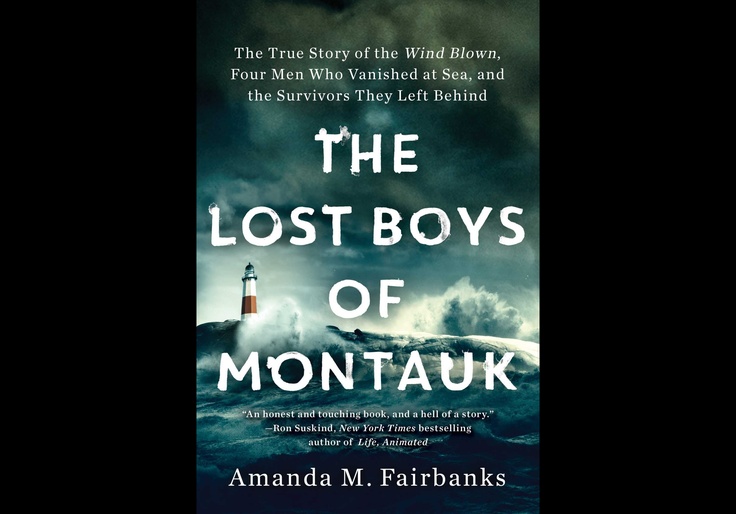"A person dies twice," a fisherman told Amanda M. Fairbanks. "The first time they die is when their body stops moving. The second time they die is when the last person stops talking about them." That could be the thesis of The Lost Boys of Montauk. The book is a testament not only to Fairbanks's writing skill and journalistic persistence—though it is that—but also to the need she felt to tell the story of Mike Stedman, Dave Connick, Michael Vigilant, and Scott Clarke, the four commercial fishermen who vanished with their boat, the Wind Blown, off Montauk Point, N.Y., in a wicked 1984 storm.
As a lifelong Long Islander who has been "out east" to Montauk—the farthest eastern point on the island and in the state of New York—in the tourist-packed summer and the quiet, empty winter, I recognized all of the locations and some of the names Fairbanks mentions. But neither I nor, I think, most Long Islanders knew the story of the Wind Blown and her crew.
Stedman, Connick, Vigilant, and Clarke left Montauk harbor on March 22, 1984, on a weeklong tilefishing trip. Stedman and Connick were sons of privilege who escaped from their parents' lives of wealth and conformity first by joining the counterculture and then by heading out to sea. "Social climbing and cocktail-party banter made their skin crawl," Fairbanks notes. Vigilant and Clarke, the Wind Blown's deckhands, were blue-collar locals who longed to make money for their families and one day be captains of their own fishing boats. According to Kim Bowman, then Vigilant's girlfriend, he had just proposed to her the day the Wind Blown set out. (Some of Fairbanks's other sources dispute Bowman's memory of a proposal—making it just one of the lingering mysteries about the Wind Blown's disappearance.)
The Wind Blown was heading 120 miles offshore, toward the edge of the continental shelf. While Stedman knew a storm was coming, he thought it was nothing the boat couldn't handle. On March 28, however, the winds picked up—and the storm became a nor'easter, "one of the most severe … in recent history" according to the National Weather Service. Stedman radioed a friend that day to say he was only about 12 miles southeast of Montauk. He radioed again the next morning, this time with trembling in his voice. No one ever heard from Stedman, or any other member of the Wind Blown's crew, again. While items from the boat have been found, a wreck never has.
In other hands, The Lost Boys of Montauk could have become a mystery story, like the many books on the Bermuda Triangle disappearance of Flight 19. To be sure, Fairbanks does a great deal of detective work and, toward the end, reveals a likely explanation for how the Wind Blown vanished, seemingly without a trace. She also reveals a genuine surprise that makes the reader reevaluate what he thought he knew. Fairbanks's real goal, however, is not to write a nonfiction thriller—it is to delve into the lives of the crew members and their families, to tell their stories and, in so doing, allow the survivors to cope with their pain.
Fairbanks also delves into another life—that of the community of Montauk. She lives in Sag Harbor, N.Y., around 25 miles from Montauk Point, and shows great love for the area and its people. Her story is deeply American, with its leading players longing for lives they get to make for themselves, damn convention and expectation. It is also deeply Long Island, intertwining the seemingly opposing notions of small-town stability and the irresistible call of the sea. The loss of the Wind Blown, Fairbanks seems to be saying, was the loss of Montauk, at least the Montauk of hardened fishermen and close-knit families. For years now, Montauk has been increasingly going the way of its neighboring towns, which get conflated as "the Hamptons."
"The Hamptons"—a term used by the New York City papers but forbidden by the local East Hampton Star—are weekend summer towns for celebrities such as Alec Baldwin, Gwyneth Paltrow, and Jerry Seinfeld. With the celebrities comes, inevitably, commercialization and the loss of charm and character—and now, Fairbanks notes, once-blue-collar Montauk may be "fast becoming the most Hamptons-like destination of them all." In the '80s, new money had just started moving into the East End. The Wind Blown's crew went down in 1984, and in many ways their Montauk went with them.
The Lost Boys of Montauk is Fairbanks's first book. She has a journalism background, however, having worked for the New York Times, the Huffington Post, and the East Hampton Star, and she crafts clear, concise, yet often beautiful prose. She sets the scene and establishes character with seeming ease and has a talent for the genuinely poetic phrase. In her acknowledgments, she writes, "Understanding the finer points of commercial fishing was like learning a foreign language," yet she explains commercial fishing so well that the reader is never confused by a technical term or description. While her lengthy descriptions of crew members' families may strike some readers as digressions, they're vital for understanding what made each man tick and for giving the reader a sense of the larger world around these men.
On every page, Fairbanks conveys to the reader why she is telling this story—why it exerted such a strong pull on her and why she has to tell it to the world. In the story of the Wind Blown, the story of these four men who fought to create their own ways in the world and the families they left behind, most readers will see themselves. And, by talking about Mike Stedman, Dave Connick, Michael Vigilant, and Scott Clarke, the four of them will not die a second time.
The Lost Boys of Montauk: The True Story of the Wind Blown, Four Men Who Vanished at Sea, and the Survivors They Left Behind
by Amanda M. Fairbanks
Gallery Books, 295 pp., $28
